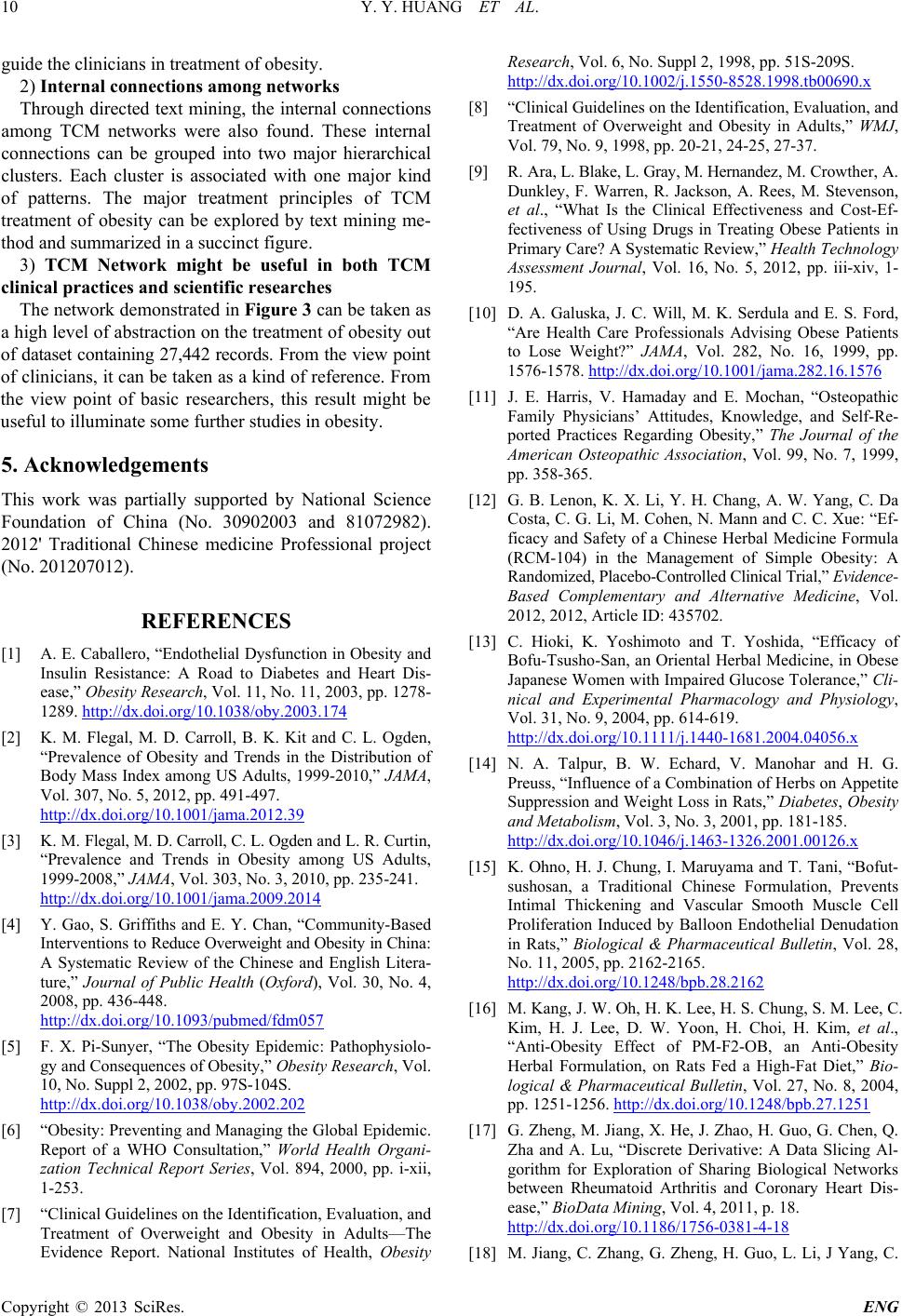
Y. Y. HUANG ET AL.
Copyright © 2013 SciRes. ENG
guide the clinicians in treatment of obesity.
2) Internal connections among networks
Through directed text mining, the internal connections
among TCM networks were also found. These internal
connections can be group e d into two major hierarchical
clusters. Each cluster is associated with one major kind
of patterns. The major treatment principles of TCM
treatment of obesity can be explored by text mining me-
thod and summarized in a succinct figure.
3) TCM Network might be useful in both TCM
clinical practices and scientific researches
The ne tw ork demonstrated in Figure 3 can be tak en as
a high level of abstraction on the treatment of obesity out
of dataset containing 27,442 recor ds. From the view point
of clinicians, it can be tak e n as a kind of refer e nce. F rom
the view point of basic researchers, this re sult might be
useful to illuminate some further studies in obesity.
5. Acknowledgements
This work was partially su pported by National Science
Foundation of China (No. 30902003 and 81072982).
2012' Traditional Chinese medicine Professional project
(No. 201207012).
REFERENCES
[1] A. E. Caballero, “Endothelial Dysfunction in Obesity and
Insulin Resistance: A Road to Diabetes and Heart Dis-
ease,” Obesity Research, Vol. 11, No. 11, 2003, pp. 1278-
1289. http://dx.doi.org/10.1038/oby.2003.174
[2] K. M. Flegal, M. D. Carroll, B. K. Kit and C. L. Ogden,
“Prevalence of Obesity and Trends in the Distribution of
Body Mass Index among US Adults, 1999-2010,” JA MA,
Vol. 307, No. 5, 2012, pp. 491-497.
http://dx.doi.org/10.1001/jama.2012.39
[3] K. M. Flegal, M. D. Carroll, C. L. Ogden and L. R. Curtin,
“Prevalence and Trends in Obesity among US Adults,
1999-2008,” JAMA, Vol. 303, No. 3, 2010, pp. 235-241.
http://dx.doi.org/10.1001/jama.2009.2014
[4] Y. Gao, S. Griffiths and E. Y. Chan, “Community-Based
Interventions to Reduce Overwei ght and Obesity in China:
A Systematic Review of the Chinese and English Litera-
ture,” Journal of Public Health (Oxford), Vol. 30, No. 4,
2008, pp. 436-448.
http://dx.doi.org/10.1093/pubmed/fdm057
[5] F. X. Pi-Sunyer, “The Obesity Epidemic: Pathophysiolo-
gy and Consequences of Obesity,” Obesity Research, Vol.
10, No. Suppl 2, 2002, pp. 97S-104S.
http://dx.doi.org/10.1038/oby.2002.202
[6] “Obesity: Preventing and Managing the Global Epidemic.
Report of a WHO Consultation,” World Health Organi-
zation Technical Report Series, Vol. 894, 2000, pp. i-xii,
1-253.
[7] “Clinical Guidelines on the Identification, Evaluation, and
Treatment of Overweight and Obesity in Adults—The
Evidence Report. National Institutes of Health, Obesity
Research, Vol. 6, No. Suppl 2, 1998, pp. 51S-209S.
http://dx.doi.org/10.1002/j.1550-8528.1998.tb00690.x
[8] “Clinical Guidelines on the Identification, Evaluation, and
Treatment of Overweight and Obesity in Adults,” WMJ,
Vol. 79, No. 9, 1998, pp. 20-21, 24-25, 27-37.
[9] R. Ara, L. Blake, L. Gray, M. Hernandez, M. Crowther, A.
Dunkley, F. Warren, R. Jackson, A. R ees, M. Stevenson,
et al., “What Is the Clinical Effectiveness and Cost-Ef-
fectiveness of Using Drugs in Treating Obese Patients in
Primary Care? A Systematic Review,” Health Technology
Assessment Journal, Vol. 16, No. 5, 2012, pp. iii-xiv, 1-
195.
[10] D. A. Galuska, J. C. Will, M. K. Serdula and E. S. Ford,
“Are Health Care Professionals Advising Obese Patients
to Lose Weight?” JAMA, Vol. 282, No. 16, 1999, pp.
1576-1578. http://dx.doi.org/10.1001/jama.282.16.1576
[11] J. E. Harris, V. Hamaday and E. Mochan, “Osteopathic
Family Physicians ’ Attitudes, Knowledge, and Self-Re-
ported Practices Regarding Obesity,” The Journal of the
American Osteopathic Association, Vol. 99, No . 7, 1999,
pp. 358-365.
[12] G. B. Lenon, K. X. Li, Y. H. Chang, A. W. Yang, C. Da
Costa, C. G. Li, M. Cohen, N. Mann and C. C. Xue: “Ef-
ficacy and Safety of a Chinese Herbal Medicine Formula
(RCM-104) in the Management of Simple Obesity: A
Randomized, Placebo-C ontro lled Clinical Trial,” Evidence-
Based Complementary and Alternative Medicine, Vol.
2012, 2012, Article ID: 435702.
[13] C. Hioki, K. Yoshimoto and T. Yoshida, “Efficacy of
Bofu-Tsusho-San, an Oriental Herbal Medicine, in Obese
Japanese Women with Impaired Glucose Tolerance,” Cli-
nical and Experimental Pharmacology and Physiology,
Vol. 31, No. 9, 2004, pp. 614-619.
http://dx.doi.org/10.1111/j.1440-1681.2004.04056.x
[14] N. A. Talpur, B. W. Echard, V. Manohar and H. G.
Preuss, “Influence of a Combination of Herbs on Appetite
Suppression and Weight Loss in Rats,” Diabetes, Obesity
and Metabolism, Vol. 3, No. 3, 2001, pp. 181-185.
http://dx.doi.org/10.1046/j.1463-1326.2001.00126.x
[15] K. Ohno, H. J. Chung, I. Maruyama and T. Tani, “Bofut-
sushosan, a Traditional Chinese Formulation, Prevents
Intimal Thickening and Vascular Smooth Muscle Cell
Proliferation Induced by Balloon Endothelial Denudation
in Rats,” Biological & Pharmaceutical Bulletin, Vol. 28,
No. 11, 2005, pp. 2162-2165.
http://dx.doi.org/10.1248/bpb.28.2162
[16] M. Kang, J. W. Oh, H. K. Lee, H. S. Chung, S. M. Lee, C.
Kim, H. J. Lee, D. W. Yoon, H. Choi, H. Kim, et al.,
“Anti-Obesity Effect of PM-F2-OB, an Ant i -Obesity
Herbal Formulation, on Rats Fed a High-Fat Diet,” Bio-
logical & Pharmaceutical Bulletin, Vol. 27, No. 8, 2004,
pp. 1251-1256. http://dx.doi.org/10.1248/bpb.27.1251
[17] G. Zheng, M. Jiang, X. He, J. Zhao, H. Guo, G. Chen, Q.
Zha and A. Lu, “Discrete Derivative: A Data Slicing Al-
gorithm for Exploration of Sharing Biological Networks
between Rheumatoid Arthritis and Coronary Heart Dis-
ease,” BioData Mining, Vol. 4, 2011, p. 18.
http://dx.doi.org/10.1186/1756-0381-4-18
[18] M. Jiang, C. Zhang, G. Zheng, H. Guo, L. Li, J Yang, C.